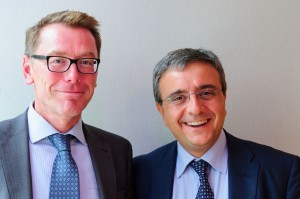 ECG president Costantino Baldissara (far right, with vice-president Wolfgang Göbel) reflects on the good, the bad, and the frustrating events of the last ten years
ECG president Costantino Baldissara (far right, with vice-president Wolfgang Göbel) reflects on the good, the bad, and the frustrating events of the last ten years
Congratulations to Finished Vehicle Logistics on ten years of coverage of our industry. This is also the 18th year of ECG so we are a (little) bit older than the magazine. For once in these pages, I intend to look back instead of forward. So, what has changed over the last decade?
Looking at the membership of our association in 2005, it confirms two things that I already was aware of. Firstly, many of those members are still with us today and they include many of the biggest and most established names in our sector, giving us a stable and representative base. Secondly, it is striking how many members have been swallowed by others in that time. The process of consolidation continues; indeed, it feels as though it is gathering pace.
Of course, the industry has also lost companies in that time, which is unsurprising given the last decade contained a financial crisis that caused the largest and fastest contraction in the automotive sector’s history. As factories shut down for weeks at a time and volumes dried up, our members had to respond fast. Those that survived have emerged leaner and more efficient than before, and yet now, starved of investment for years, the industry lacks the capacity and flexibility to support a growing market.
From a technological viewpoint it is surprising both how much has changed but also how little! Who would have thought that we would still be using paper delivery notes in 2015? Surely by now we all expected that we would be using RFID or something better in operations across the industry (see survey on p28). If phone manufacturers can standardise their plugs, surely the automotive industry can come up with standard systems for handling its products?
In the maritime world we have seen development of larger and ever more efficient ships, the introduction of slow steaming and the challenges of the Sulphur Emission Control Areas. Continuously rising oil prices combined with legislation have, until recently, ensured focus on using less fuel and producing fewer emissions.
Still far from a single transport market
Surprisingly, there has been less development on the road. There is great resistance in many quarters to the use of larger and more efficient trucks, the so-called European Modular System. Legislation has, however, ensured that Euro 5 and now Euro 6 trucks have improved fuel consumption and emissions. Legislators continue to add complex technical requirements for trucks, which are driving costs up at a significant rate.
It is also ten years since road tolls were introduced in Germany (the MAUT) and since then many more countries have followed suit, with more systems yet to be implemented. Regrettably, there has been no European standard agreed for the technology and it is especially in road transport where the ‘single market’ is far from being achieved.
The current cabotage laws were introduced in 2010 and have gone some way to improving efficiency, but further liberalisation has b((een dropped from the agenda for the foreseeable future pending harmonisation of wages and living standards across the 28 EU member states.
Unfortunately, however, the latest movements by some of those countries have started to recreate borders in Europe through the introduction of national legislation. This includes the minimum wage laws of Germany and the French decision to prevent drivers taking weekend breaks in their cabs. Rightly or wrongly, these moves impair the operation of a single European market. Worse still, of course, the movement of migrants across Europe is hampering road operations in many places and even threatening the continued existence of the borderless Schengen area.
In the rail sector, legislation has made slow progress(. In Brussels they are now trying to get the 4th Railway Package adopted and in many respects this mode is still operating on a national rather than a European basis. There is much to do if we are to maximise the potential of rail in Europe and to achieve the visions of more multimodal transport contained in the European Commission’s Transport White Paper.
However, the biggest challenges facing the vehicle logistics industry make familiar reading. Accuracy of forecasts remain one of the biggest concerns. A lack of standardisation is still a challenge in many areas. Empty running driven by unbalanced flows has got worse as the years have seen increased production in eastern Europe.
In looking to the future, I’d like to remind you of an opportunity where we can do that together. The ECG Conference will be held once again on October 15-16 in co-operation with Finished Vehicle Logistics, in Vienna, Austria. Appropriately, this year’s theme is ‘Back to the Future’.

























![Global[1]](https://d3n5uof8vony13.cloudfront.net/Pictures/web/a/d/s/global1_726550.svgz)









